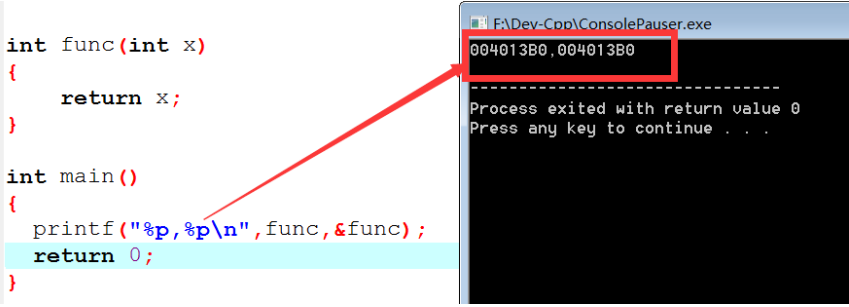函数指针
1.首先来讲讲函数
其实每个函数名,都是函数的入口地址,如下图所示:

其中0x4013B0就是上图的func()函数的入口地址,从上图可以看到,func和&func的地址都一样,所以&对于函数而言,可以不需要
2.接下来便使用函数指针来指向上面func()函数
实例1如下:
#include "stdio.h" int func(int x) { return x; } int main() { int (*FP)(int); //定义FP函数指针 FP=func; //FP指向func的地址 printf("%d\n",FP(1)); printf("%p,%p\n",FP,func); return 0; }
输出结果:
1 //调用func()函数 004013B0,004013B0
2)当使用typedef时,函数指针使用如下:
#include "stdio.h" int func(int x) { return x; } typedef int (*FP)(int); //使用声明函数指针类型FP int main() { FP a; //通过FP,定义函数指针a a=func; //a指向func的地址 printf("%d\n",a(1)); printf("%p,%p\n",a,func); return 0; }
3)其实也可以先声明函数类型,再来定义函数指针:
#include "stdio.h" int func(int x) { return x; } typedef int (FP)(int); //使用声明函数类型FP int main() { FP* a; //通过FP,定义函数指针a a=func; //a指向func的地址 printf("%d\n",a(1)); printf("%p,%p\n",a,func); return 0; }
3.函数指针数组
示例:
#include <iostream> using namespace std; void func1(int i) { cout<<"func1"<<endl; } void func2(int i) { cout<<"func2"<<endl; } void func3(int i) { cout<<"func3"<<endl; } void func4(int i) { cout<<"func4"<<endl; } int main() { void (*fp[3])(int); fp[0]=func1; fp[1]=func2; fp[2]=func3; fp[0](1); }
人间有真情,人间有真爱。


